Comb-footed Platform Spider - Achaearanea mundula

- Female, body length 7mm
- The Comb-footed Platform Spiders are common in Brisbane Eucalypt forest. Females are dark orange to dark reddish-brown in colours with white markings and pale patterns on the abdomen. It seems that those younger females are orange in colour. When they grow they become darker. Males are oranges in colours with white marking on top of abdomen.
FAMILY THERIDIIDAE
This page contains pictures and information about Comb-footed Platform Spiders that we found in the Brisbane area, Queensland, Australia.
Female
-

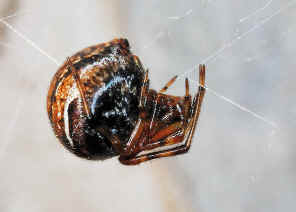
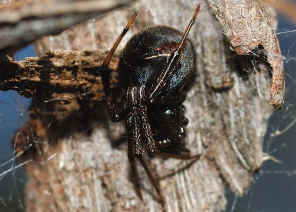
- Comb-footed Platform Spiders build tangled webs between large gum tree trunks where the gap is usually 0.5 meter. There is always a curled leaf or pieces of debris as retreat at the middle.
-



Male
-



- Males look simular but half the size of female. During mating season (Nov in Brisbane), males are seen around female's retreat. Sometimes two or more males can be seen approaching a female.


-



- Inside the retread females make the ball shape egg-sacs, 6-8mm in diameter.
-



-
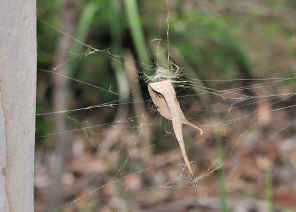





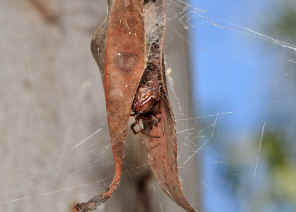

- Comb-footed Platform Spiders build tangled web, which is a messy network of threads between tree trunks, a curled leaf or pieces of debris as retreat at the middle. Under the threads occasionally they build a close-mesh horizontal sheet web. They prey on all different insects include small to medium size.
-



- Their tangled web structure may not be as sophisticated as those orb web, or you may not even call them a web. But they are effective in capturing prey. Those tangled webs are usually build between tree trunks which are 0.5 meter apart and 1 meter above ground. this gap of 0.5 meter opening in the forest is a general pathway for flying insects.
-


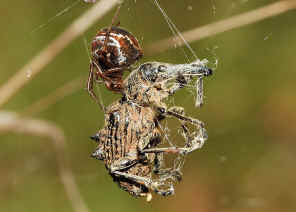
- The ants walking up and down along the tree trunks sometimes fallen onto the web which become the prey as well. From the remains on the spider webs, those fallen ants are one of their major food source.
- From those spider photos above, we noticed that they can be separated in two groups. One group is paler in orange colour and builds retreat with dry curl leaves. The other group is darker in black colour and builds retreat with small price of fallen barks. They may be in two separated species.
- Reference:
- 1. Achaearanea mundula - The Find-a-spider Guide for the Spiders of Southern Queensland, Dr Ron Atkinson, 2006.
- 2. Achaearanea mundula Comb Footed Platform Spider - Robert Whyte, Save Our Waterways Now.
